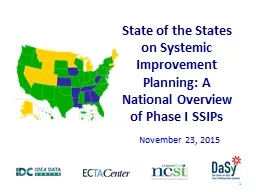

State of the States on Systemic Improvement Planning A National Overview of Phase I SSIPs November 23 2015 1 Intended Outcomes Participants will Gain an understanding how data were collected and summarized for Phase I ID: 763950
Download Presentation The PPT/PDF document "State of the States on Systemic Improvem..." is the property of its rightful owner. Permission is granted to download and print the materials on this web site for personal, non-commercial use only, and to display it on your personal computer provided you do not modify the materials and that you retain all copyright notices contained in the materials. By downloading content from our website, you accept the terms of this agreement.
State of the States on Systemic Improvement Planning: A National Overview of Phase I SSIPs November 23, 2015 1
Intended Outcomes Participants will:Gain an understanding how data were collected and summarized for Phase I Gain an understanding of what states are doing compared to other states including what states are doing similar thingsKnow how the SSIP Phase I Content Analysis will inform TA to statesKnow where to find more information about the SSIP Phase I Analysis 2
SSIP Content Analysis Process Method 1 (40 states)Each state Part C SSIP reviewed by components by a Component Reviewer (for components 1 through 4)Checked by a second component reviewerDiscrepancies checked and codes verified by a third component reviewer Component coding verified by an overall reviewer (who read the entire state SSIP) 3
SSIP Content Analysis Process (cont.) Method 2 (16 state SSIPs)Each state SSIP reviewed in its entirety by an SSIP reviewerChecked by a second SSIP reviewerDiscrepancies checked and codes verified by a third reviewer 4
Highlights from the SSIP Content Analysis 5
All states were required to conduct analysis of key data to identify areas of low performance to address with improvement strategies. Component 1 – Data Analysis 6
Data Sources Used Across Programs/Agencies 7
Results - Data Disaggregation 8
States were required to do additional analysis to identify root causes of low performance. Methods used to conduct the root cause analysis included: Stakeholder discussion (98%) Review of existing data (98%)Survey (50%)Other (20%) Root Cause Analysis 9
Poll 110
All states were required to conduct analysis of their infrastructure to identify which components have strengths to be leveraged, and which components need improvement. Component 2 – Infrastructure Analysis 11
Component 2 – State Identified Needs in Infrastructure Analysis 12
Infrastructure Analysis: Professional Development Needs (N=56) 13
Accountability Needs (N=55) 14
Poll 215
Based on data and infrastructure analyses, states were required to identify the state-identified measurable result(s ) for children and families that are intended to be achieved through the implementation of the SSIP. Component 3: SIMR 16
Child and Family Outcomes targeted by State Selected SIMRs (N=56) 17
MH HI GU PW FM AS MP States’ selected SIMRs for Part C FFY 2013 (2013-2014) Legend Child Outcomes: C3A- Social relationships C3B- Knowledge and skills C3C- Meeting own needs C3A, B, and C VI PR Family Outcomes: C4A- Know their rights C4B- Communicate children’s need C4C- Help their children develop and learn Other- NY: All 3 Family Outcomes + other content; MP: Selected domains from assessment tool 18
SIMR Subpopulations (N=25) 19
Poll 3, a and b20
Component 4: Improvement StrategiesStates were required to identify improvement strategies that improve the infrastructure, support implementation of evidence-based practices, and ultimately improve the SIMR. 21
22
MH HI GU PW FM AS MP States including their fiscal systems in their SSIP improvement strategies for Part C FFY 2013 (2013-2014) Legend: Included fiscal systems Did not include fiscal systems VI PR Note: Strategies included improved fiscal planning; changes in funds procurement; and improved resource allocation, use of funds 23
Focus of Improvement Strategies Related to Professional Development Systems (N=54) 24
Strategies Incorporating Models of Evidence-based Practices (N=56) 25
Strategies for Improving Data Quality (N=48) 26
Poll 427
Component 5: Theory of ActionStates were required to develop a graphic illustration (a Theory of Action) to show the rationale of how implementing their coherent set of improvement strategies will increase the State’s capacity to lead meaningful change at the local level and ultimately achieve improvement in the SIMR. 28
Levels of Strategies in Theory of Action (N=56) 29
Theory of Action Format 30
Stakeholder Involvement in Phase I Stakeholders are critical participants in improving results for infants and toddlers with disabilities and their families. 31
Stakeholders Involved 32
MH HI GU PW FM AS MP 619 Involvement in State SSIPs FFY 2013 (2013-2014) Legend: Included in the development of the Part B SSIP Included in the SIMR for the Part C SSIP Focus of the Part B SSIP Not included in the development of the SSIP VI PR 33
Percent of states including 619 in the development of the Part B SSIP by age focus of the SIMR 34
Implications for TA SSIP content analysis data are being used by TA centers in the following waysPlanning topics for national webinars and productsConnecting states to others with similar strategiesIdentifying high quality processes to share with other states 35
SSIP Content Analysis Resources 2015 SPP/APR Indicator Analyses - A national quantitative picture of the implementation of the Parts B and Part C of the Individuals with disabilities Education Act (IDEA). Part B SPP/APR 2015 Indicator Analyses Part C SPP/APR 2015 Indicator Analyses Phase I SSIP Content Analysis State Maps http://ectacenter.org/topics/ssip/ssip_p1.asp#maps36
Phase II Resources Sample SSIP Action Plan Template - Provides states with a suggested, but not required, format and examples of potential content to assist them in completing their Phase II SSIP improvement plan and evaluation plan http://ectacenter.org/~docs/topics/ssip/ssip_improvement_plan_template.docSSIP Phase II Process Guide - Describes the steps needed to accomplish the work of the three components of Phase II http://ectacenter.org/topics/ssip/ssip_phase2.asp37
Contact Us Anne Lucas Anne.Lucas@unc.edu Lynne Kahn Lynne.Kahn@unc.eduTaletha Derringtontaletha.derrington@sri.com Kathy WhaleyKathy.Whaley@unc.eduAbby WinerAbby.Winer@sri.com Cornelia Taylor Cornelia.Taylor@sri.comRobin Nelsonropnelson@hotmail.com Carolee EslingerCaroleeEslinger@westat.comAlise Paillardapaillard@wested.org 38